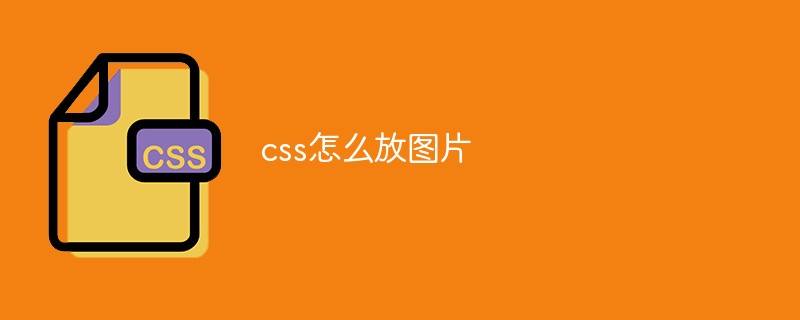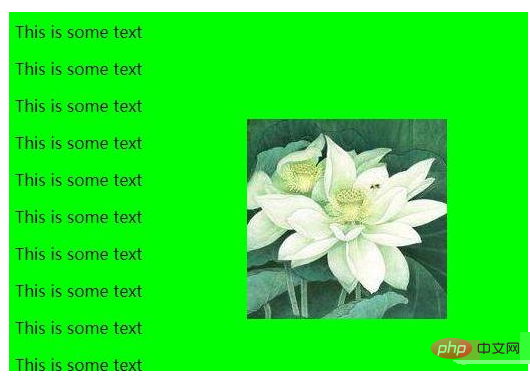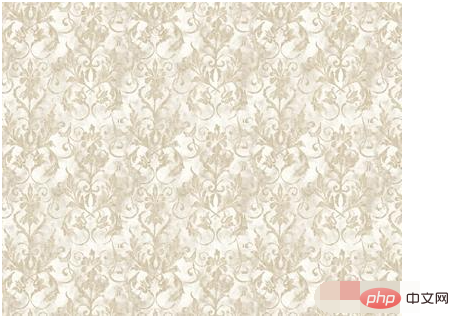How to put pictures in css
How to put pictures in css: 1. Use the background abbreviation attribute to introduce pictures when setting the background; 2. Directly use the background-image attribute to introduce background pictures.

The operating environment of this article: Windows7 system, HTML5&&CSS3 version, Dell G3 computer.
How to put pictures in css?
With the development of the Internet, network speed continues to increase, and our current web pages have become richer. In addition to being able to transmit text, we can also transmit pictures. How do we use css to place images on web pages? Let's take a look at how to use css to place images on web pages.
css You can use the background abbreviation attribute to introduce an image when setting the background, or you can use the background-image attribute to introduce a background image. The background-image property sets the background image for the element.
Use the background abbreviation attribute to introduce images:
<!DOCTYPE html>
<html>
<head>
<meta charset="utf-8">
<title></title>
<style>
body
{
background: #00ff00 url('img/3.jpg') no-repeat fixed center;
}
</style>
</head>
<body>
<p>This is some text</p>
<p>This is some text</p>
<p>This is some text</p>
<p>This is some text</p>
<p>This is some text</p>
<p>This is some text</p>
<p>This is some text</p>
<p>This is some text</p>
<p>This is some text</p>
<p>This is some text</p>
<p>This is some text</p>
</body>
</html>Rendering:

Use the background-image attribute to place images in the web page:
<html>
<head>
<style type="text/css">
body {background-image:url(/i/eg_bg_04.gif);}
</style>
</head>
<body></body>
</html>Rendering:

background shorthand attribute:
background shorthand attribute sets all background attributes in one statement.
You can set the following attributes:
background-color background-position background-size background-repeat background-origin background-clip background-attachment background-image
If you don’t set one of the values, there will be no problem. For example, background:#ff0000 url('smiley.gif'); is also allowed. .
It is generally recommended to use this attribute instead of using individual attributes separately, because this attribute is better supported in older browsers and requires fewer letters to be typed.
background-image attribute: The
background-image attribute sets the background image for an element. The background of an
element occupies the entire size of the element, including padding and borders, but not margins.
By default, the background image is placed in the upper left corner of the element and repeats horizontally and vertically.
Tip: Please set an available background color so that the page can get good visual effects even if the background image is not available.
Attribute value:
url('URL') Path pointing to the image.
none Default value. No background image is displayed.
inherit specifies that the setting of the background-image attribute should be inherited from the parent element.
【Recommended learning: css video tutorial】
The above is the detailed content of How to put pictures in css. For more information, please follow other related articles on the PHP Chinese website!

Hot AI Tools

Undresser.AI Undress
AI-powered app for creating realistic nude photos

AI Clothes Remover
Online AI tool for removing clothes from photos.

Undress AI Tool
Undress images for free

Clothoff.io
AI clothes remover

Video Face Swap
Swap faces in any video effortlessly with our completely free AI face swap tool!

Hot Article

Hot Tools

Notepad++7.3.1
Easy-to-use and free code editor

SublimeText3 Chinese version
Chinese version, very easy to use

Zend Studio 13.0.1
Powerful PHP integrated development environment

Dreamweaver CS6
Visual web development tools

SublimeText3 Mac version
God-level code editing software (SublimeText3)

Hot Topics
 1664
1664
 14
14
 1423
1423
 52
52
 1317
1317
 25
25
 1268
1268
 29
29
 1248
1248
 24
24
 How to use bootstrap in vue
Apr 07, 2025 pm 11:33 PM
How to use bootstrap in vue
Apr 07, 2025 pm 11:33 PM
Using Bootstrap in Vue.js is divided into five steps: Install Bootstrap. Import Bootstrap in main.js. Use the Bootstrap component directly in the template. Optional: Custom style. Optional: Use plug-ins.
 Understanding HTML, CSS, and JavaScript: A Beginner's Guide
Apr 12, 2025 am 12:02 AM
Understanding HTML, CSS, and JavaScript: A Beginner's Guide
Apr 12, 2025 am 12:02 AM
WebdevelopmentreliesonHTML,CSS,andJavaScript:1)HTMLstructurescontent,2)CSSstylesit,and3)JavaScriptaddsinteractivity,formingthebasisofmodernwebexperiences.
 The Roles of HTML, CSS, and JavaScript: Core Responsibilities
Apr 08, 2025 pm 07:05 PM
The Roles of HTML, CSS, and JavaScript: Core Responsibilities
Apr 08, 2025 pm 07:05 PM
HTML defines the web structure, CSS is responsible for style and layout, and JavaScript gives dynamic interaction. The three perform their duties in web development and jointly build a colorful website.
 How to insert pictures on bootstrap
Apr 07, 2025 pm 03:30 PM
How to insert pictures on bootstrap
Apr 07, 2025 pm 03:30 PM
There are several ways to insert images in Bootstrap: insert images directly, using the HTML img tag. With the Bootstrap image component, you can provide responsive images and more styles. Set the image size, use the img-fluid class to make the image adaptable. Set the border, using the img-bordered class. Set the rounded corners and use the img-rounded class. Set the shadow, use the shadow class. Resize and position the image, using CSS style. Using the background image, use the background-image CSS property.
 How to write split lines on bootstrap
Apr 07, 2025 pm 03:12 PM
How to write split lines on bootstrap
Apr 07, 2025 pm 03:12 PM
There are two ways to create a Bootstrap split line: using the tag, which creates a horizontal split line. Use the CSS border property to create custom style split lines.
 How to set up the framework for bootstrap
Apr 07, 2025 pm 03:27 PM
How to set up the framework for bootstrap
Apr 07, 2025 pm 03:27 PM
To set up the Bootstrap framework, you need to follow these steps: 1. Reference the Bootstrap file via CDN; 2. Download and host the file on your own server; 3. Include the Bootstrap file in HTML; 4. Compile Sass/Less as needed; 5. Import a custom file (optional). Once setup is complete, you can use Bootstrap's grid systems, components, and styles to create responsive websites and applications.
 How to resize bootstrap
Apr 07, 2025 pm 03:18 PM
How to resize bootstrap
Apr 07, 2025 pm 03:18 PM
To adjust the size of elements in Bootstrap, you can use the dimension class, which includes: adjusting width: .col-, .w-, .mw-adjust height: .h-, .min-h-, .max-h-
 How to use bootstrap button
Apr 07, 2025 pm 03:09 PM
How to use bootstrap button
Apr 07, 2025 pm 03:09 PM
How to use the Bootstrap button? Introduce Bootstrap CSS to create button elements and add Bootstrap button class to add button text




